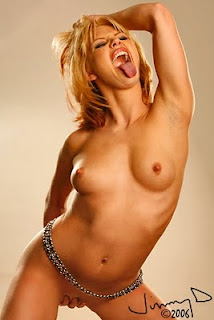 Read an online article today about Photographic Standards. I'll rephrase that to "Photographic Standards of Excellence."
Read an online article today about Photographic Standards. I'll rephrase that to "Photographic Standards of Excellence."In a nutshell, the article recounted the three, major criteria Time-Life used when selecting photographers for its "Great Photographers" volume of their Time-Life Photography series. There were ten factors considered, but these three were foremost in the minds of whoever selected the shooters: Intent, skill, and consistency. (You might want to read the article, linked above, to read about all the criteria used.)
In the world of glamour shooting, intent is fairly obvious: To capture the allure of the model. This, of course, differs from most fashion work. In fashion, the intent is to capture the allure of a product, often with the help of an alluring model. Glamour is all about the model. Fashion, for the most part, is all about the product. In most fashion work, if the model upstages the product it's not considered a good thing, leastwise, traditionally and for the most part. That's one reason why fashion models don't often make eye contact with the camera. (Not saying there aren't exceptions to my observations. Just saying that's how it is for the majority of the work.)
Skill is fairly obvious: The photographer's skills should be evident in the photo. That includes everything from exposure to composition to lighting and beyond. I'm often harping, here on the blog, on developing your production skills first and your post-production skills second. You should note that post-production skills aren't even mentioned in Time-Life's criteria-- Not in their most important three factors nor any of the ten factors also mentioned.
Consistency is the third factor. What this means is it's not enough to occasionally snap a great pic. (By design, by accident, or by serendipity.) What is important is whether you, as a photographer, can consistently snap great photos, i.e., can you deliver the goods on demand each and every time you shoot.
In the professional world of glam shooting, consistency is everything. Clients want to know that, as a minimum, the photographer can capture good images--hopefully, great images--every time they're hired. A photographer might be hired based on the wow-ness of a single image in his or her portfolio. That has certainly happened to me on more than one occasion. But you're only as good as the last time you shot for any given client. That means you have to deliver, at a minimally acceptable level, each and every time you shoot for your client. And it's the client who decides what constitutes those minimally acceptable levels. That's why I mostly strive to exceed my clients' expectations. If I screw up, leastwise in my mind, the screwed-pics still usually meet the clients' minimal standards.
Well, there you have it. Whether you're hoping to someday be selected by Time-life's editors for inclusion in their "Great Photographers" book or not, I'd highly recommend trying your best and doing whatever it takes to achieve intent, skill, and consistency in your photography. And doing so in ways that are recognizable in your photographs.
The pretty girl at the top is Katarina, snapped in 2006 at a non-descript location in down-town Los Angeles. I'm not always in love with my own work, in fact I beat myself up over it often enough, but I do love this photo. Although it's a simple, no frills image, it remains one of my personal, all-time-favorite, pretty girl pics. Leastwise, of the stuff I've shot. Go figure, right? I wouldn't categorize it as glamour. I don't know what I'd call it. How about "whatever."








